Carnets de Géologie / Notebooks on Geology: Book 2009/03, Chapter 2 (CG2009_B03/02)
X., X., C. & L. (2009).- The Triassic Guanling fossil Group - A key GeoPark from a barren mountain, Guizhou Province, China.- In: J.H. & B.R.C. (eds.), PaleoParks - The protection and conservation of fossil sites worldwide.- Carnets de Géologie / Notebooks on Geology, Brest, Book 2009/03, Chapter 02 (CG2009_B03/02)
Deposited about 220 million years ago, the Late Triassic Guanling Fossil Group in Guanling County, SW Guizhou Province, China, preserves a diverse assemblage of vertebrate and invertebrate fossils in black mudstone and shale of the upper Lower Member of the Xiaowa Formation (Early Carnian). These rocks are exposed over 200 km2, and contain numerous well-preserved marine reptiles (ichthyosaurs, thalattosaurs, placodonts), pelagic multifarious crinoids, and ammonoids, bivalves, conodonts, brachiopods, elasmobranch ichthyoliths, and rare fossil fish and plants. Nowhere else in deposits of this age are so many marine reptile skeletons and pelagic crinoids preserved so perfectly and in such abundance. The litho-, sequence- and bio- stratigraphy indicate that the black mudstone and shale were deposited during the Late Triassic Indo-Sinian orogenesis, most likely in a marginal depression or restricted basin on SW Yangtze Platform, with relatively reduced sedimentation rates and stagnant anoxic bottom waters.
In order to protect the exceptional Guanling fossil deposit, the Guanling Fossil Group GeoPark was established in 2003, later (2004) upgraded to the Guanling Fossil Group National GeoPark. Its aims are to allow scientific study (including fossil collection), to permit public educational and recreational activities, and to improve the appearance of the barren mountain areas in Guizhou Province. The GeoPark includes a natural history museum and exhibition site in its Wolonggang central conservation zone, near Xiaowa Village. These provide exhibits showing various fossils in their original position on the black shale and mudstone bedding planes including large, complete marine reptile skeletons and pseudo-planktonic Traumatocrinus colonies attached to coalified driftwood as well as other associated invertebrate and vertebrate fossils. Since the establishment of the GeoPark, awareness of the fossils, increased government interest, and expanded tourism benefitted the relatively poor and less developed mountain areas economically. The mountains are also losing their barren look.
Guanling; fossil group; marine reptiles; crinoids; Late Triassic; GeoPark.
Le Groupe fossilifère triasique de Guanling - Un Géoparc majeur dans un pays perdu, Province de Guizhou, Chine.- Déposées il y a 220 Ma d'années, au Trias supérieur, les marnes et pélites de Guanling (SW de la Province de Guizhou), contiennent des associations remarquables de vertébrés et d'invertébrés. Appelées "Groupe fossilifère de Guanling", ces couches forment la partie supérieure du Membre inférieur de la Formation Xiaowa, elle-même datée du Carnien inférieur. Ces terrains qui affleurent sur près de 200 km2 recèlent de restes bien conservés de reptiles (Ichthyosaures, Telattosaures, Placodontes), Crinoïdes pélagiques, Ammonoïdes, bivalves, Conodontes, Brachiopodes, ichthyolites d'Elasmobranches, et, plus rarement, des poissons et des plantes fossiles. Nulle part ailleurs, à cette époque, on ne peut observer de restes de Reptiles et Crinoïdes pélagiques aussi bien préservés et aussi abondants. La lithologie et la biostratigraphie indiquent que ces marnes noires et pélites ont été déposées au Trias supérieur pendant l'orogenèse indo-sinienne et plus précisément, dans un bassin marginal plus ou moins ouvert, au SW de la Plateforme du Yangtze, dans un contexte de sédimentation réduite à tendances anoxiques.
Afin de protéger ces exceptionnels dépôts fossilifères, le "Guanling Fossil Group Geopark" a été créé en 2003, puis requalifié en 2004 en "Guanling Fossil Group National Geopark". Il a pour mission d'encourager les études scientifiques et notamment la constitution de collections, de proposer au public des activités éducatives mais aussi de détente et de valoriser un secteur assez déshérité de la Province de Guizhou. Ce parc géologique comprend un musée d'histoire naturelle, et, au centre de la zone protégée de Wolonggang, près du village de Xiaowa, un lieu d'exposition qui présente les fossiles dans leur contexte rocheux originel. On y montre, en particulier, de grands squelettes complets de reptiles marins, des colonies pseudo-planctoniques de Traumatocrinus encore attachées à des bois flottés, maintenant charbonneux, ainsi que divers organismes associés, vertébrés et invertébrés. Grâce aux fossiles, depuis l'établissement de ce parc et avec l'arrivée des touristes, cette région montagneuse, assez pauvre et isolée, est entrée en développement.
Guanling ; groupe fossilifère ; reptiles marins ; crinoïdes ; Trias supérieur ; Géoparc.
Guanling Buyi-Miao Minority Autonomous County (or Guanling County for short) is located in the southwestern Guizhou Province, SW China. It includes 1,468
km2 with a population of 320,000 composed of 23 nationalities. Among them Buyi and Miao minorities are the most numerous. Guanling Town is 140 km SW of Guiyang, the capital of Guizhou Province, and about 40 km from the well-known Huangguoshu waterfall (Fig. 1 ![]() ). About eight years ago, the Guanling area was considered one of relatively poorest and least developed areas in China. However, it is now becoming a vibrant tourism and culture belt between Guizhou Province and Yunnan Province with the discovery and study of Guanling fossil group (GFG) and the establishment of the Guanling Fossil Group National GeoPark (GFGNG), including the Huangjiang Big Gorge nearby, the so called "the crack of the earth" (Fig. 2.a-c
). About eight years ago, the Guanling area was considered one of relatively poorest and least developed areas in China. However, it is now becoming a vibrant tourism and culture belt between Guizhou Province and Yunnan Province with the discovery and study of Guanling fossil group (GFG) and the establishment of the Guanling Fossil Group National GeoPark (GFGNG), including the Huangjiang Big Gorge nearby, the so called "the crack of the earth" (Fig. 2.a-c ![]() ). All of this is served by a new super-highway. The centre of GFGNG (Guanling Fossil Group National Paleo-park), a key conservation zone, covers 26 km2, lying on the small hill named Wolonggang near Xiaowa Village, 40 km SW of Guanling Town. It is surrounded by the mountains and terraced fields with a beautiful karst landscape and the special minorities who gather (Fig. 3.a-b
). All of this is served by a new super-highway. The centre of GFGNG (Guanling Fossil Group National Paleo-park), a key conservation zone, covers 26 km2, lying on the small hill named Wolonggang near Xiaowa Village, 40 km SW of Guanling Town. It is surrounded by the mountains and terraced fields with a beautiful karst landscape and the special minorities who gather (Fig. 3.a-b ![]() ). With the establishment of the GFGNG with a natural history museum that attracts much attention, the poor and less developed mountain areas began to take on a new look. This special GeoPark provides an interesting view of the life some 220 million years ago during the Late Triassic. Not only do scientists study the rare, well-preserved marine reptile (or marine "dragon" in Chinese) skeletons, pelagic multifaceted crinoids and a variety of other fossils, but the general public also learn from and enjoy the exceptional fossils and their high quality preservation in the rock (Fig. 4.a-b
). With the establishment of the GFGNG with a natural history museum that attracts much attention, the poor and less developed mountain areas began to take on a new look. This special GeoPark provides an interesting view of the life some 220 million years ago during the Late Triassic. Not only do scientists study the rare, well-preserved marine reptile (or marine "dragon" in Chinese) skeletons, pelagic multifaceted crinoids and a variety of other fossils, but the general public also learn from and enjoy the exceptional fossils and their high quality preservation in the rock (Fig. 4.a-b ![]() ).
).
The Guanling area is key to the middle and lower Upper Triassic stratigraphy and palaeontology in southwestern China. The Middle and Upper Triassic rocks are widespread in this area and subdivided in ascending order into: the Guanling Formation, Yangliujing Formation, Zhuganpo Formation (= Zhuganpo Member of Falang Formation (sensu et alii, 1979), Xiaowa Formation
(sensu X. et alii, 2002a,
2002b) (or Wayao Member of the Falang Formation (sensu et alii, 1979) or Wayao Formation (sensu et alii,
1995) and Leishike Formation (Table 1 ![]() ; Fig. 5
; Fig. 5 ![]() ). The stratotype sections of these formations, except for the last one, are well exposed in road cuts along the N° 320 highway from Yongnian Town to Huangtutang Village, Guanling County (Guizhou Bureau,
1987; et alii, 1997) (Fig. 1
). The stratotype sections of these formations, except for the last one, are well exposed in road cuts along the N° 320 highway from Yongnian Town to Huangtutang Village, Guanling County (Guizhou Bureau,
1987; et alii, 1997) (Fig. 1 ![]() ). The type locality for Falang Formation is at Falang Village, near the Huangjiang Big Gorge, ca 40 km south of Guanling Town (,
1940; & ,
1944). Detailed investigation and systematic exploration indicate that the GFG is mainly preserved in the black shales of upper Lower Member of the Xiaowa Formation which is 5m to 11m above the base of the Lower Member of Xiaowa Formation (former "Wayao Formation") (or previously the Wayao Formation or Wayao Member of the Falang Formation) ( X. et alii,
2002a, 2002b, 2003a,
2003b, 2004, 2008) (Fig. 5
). The type locality for Falang Formation is at Falang Village, near the Huangjiang Big Gorge, ca 40 km south of Guanling Town (,
1940; & ,
1944). Detailed investigation and systematic exploration indicate that the GFG is mainly preserved in the black shales of upper Lower Member of the Xiaowa Formation which is 5m to 11m above the base of the Lower Member of Xiaowa Formation (former "Wayao Formation") (or previously the Wayao Formation or Wayao Member of the Falang Formation) ( X. et alii,
2002a, 2002b, 2003a,
2003b, 2004, 2008) (Fig. 5 ![]() ). The black shale is 6m thick and includes intercalated black thin and medium bedded mudstone and limestone.
). The black shale is 6m thick and includes intercalated black thin and medium bedded mudstone and limestone.
The black shales bearing the GFG are widespread in Huangtutang, Bamaoling of Xinpu Village and Baiyan of Gangwu Village, Guanling County, covering about 200 km2
(Fig. 1 ![]() ). Structurally, it is situated in the centre of the Xinpu Synclinorium, a large and rather complicated NW-SE striking synform with outcropping Middle to Upper Triassic strata (Fig. 6
). Structurally, it is situated in the centre of the Xinpu Synclinorium, a large and rather complicated NW-SE striking synform with outcropping Middle to Upper Triassic strata (Fig. 6 ![]() ) ( X. et alii,
2002a, 2002b, 2003a,
2003b).
) ( X. et alii,
2002a, 2002b, 2003a,
2003b).
The Guanling fossil group is characterized by the occurrence of numerous well preserved Late Triassic (Carnian) marine reptiles and crinoids with ammonoids, bivalves, conodonts, brachiopods, elasmobranch ichthyoliths and a few fossil fishes and plants ( X. et alii,
2003a, 2003b). It should not be confused with the Panxian and Xingyi biotas, separately reported from Xingyi and Panxian areas of West Guizhou Province in marine reptile assemblage and age (Fig. 5 ![]() ) ( L. et alii,
2001; , 2001,
2006; Y. et alii,
2004). The Paxian biota occurs in the upper Guanling Formation of early Late Anisian age with the reptiles (mixosaurs, nothosaurs, lariosaurs) and fishes, such as Saurichthys, etc., while the Xingyi biota is dominated by occurrence of a great number of Keichousaurus skeletons in the lowermost Zhuganpo Formation of Early or Middle Ladinian age with Nothosauris. They both differ from the Guanling biota in their biological assemblages and age. The GFG was called the Guanling fauna ( Y. et alii,
2000) and later revised as the Guanling biota because of discovery of associated fossil plants ( X. et alii,
2000). It is a unique Late Triassic marine reptile and crinoid "Fossillagerstätte" ( X. et alii,
2002a, 2002b, 2003a,
2003b, 2004, 2008). The deposits were recognized by the Ministry of Land and Resources (MLR) as the Guanling Fossil Group National GeoPark in order to be easily understandable to the general public.
) ( L. et alii,
2001; , 2001,
2006; Y. et alii,
2004). The Paxian biota occurs in the upper Guanling Formation of early Late Anisian age with the reptiles (mixosaurs, nothosaurs, lariosaurs) and fishes, such as Saurichthys, etc., while the Xingyi biota is dominated by occurrence of a great number of Keichousaurus skeletons in the lowermost Zhuganpo Formation of Early or Middle Ladinian age with Nothosauris. They both differ from the Guanling biota in their biological assemblages and age. The GFG was called the Guanling fauna ( Y. et alii,
2000) and later revised as the Guanling biota because of discovery of associated fossil plants ( X. et alii,
2000). It is a unique Late Triassic marine reptile and crinoid "Fossillagerstätte" ( X. et alii,
2002a, 2002b, 2003a,
2003b, 2004, 2008). The deposits were recognized by the Ministry of Land and Resources (MLR) as the Guanling Fossil Group National GeoPark in order to be easily understandable to the general public.
Since the original research on the Guanling biota and excavations made by a Chinese research group organized X. et alii
(2002a, 2002b, 2003a,
2003b), a Chinese-European research group has been re-investigating the quarries and fossil collections since 2002. The principal marine reptiles of the GFG include ichthyosaurs, thalattosaurs and placodonts ( X. et alii, 2008). The ichthyosaurs include the small to medium-sized Qianichthyosaurus zhoui
C., 1999 ( et alii,
2002) (Fig. 7 ![]() ), the medium-sized to large Ghuizhouichthyosaurus tangae & in et alii,
2000 (= Cymbospondylus asiaticus
C. & , 2002 and = Panjiangsaurus epicharis
X. & , 2003) (Fig. 8
), the medium-sized to large Ghuizhouichthyosaurus tangae & in et alii,
2000 (= Cymbospondylus asiaticus
C. & , 2002 and = Panjiangsaurus epicharis
X. & , 2003) (Fig. 8 ![]() ). The largest and rarest is the remarkably small-headed Guanlingichthyosaurus liangae which probably belongs to the Shastasauridae.
). The largest and rarest is the remarkably small-headed Guanlingichthyosaurus liangae which probably belongs to the Shastasauridae.
The principal thalattosaurs include the small Xinpusaurus with two species, the common X. suni Yin ( et alii,
2000) (Fig. 9 ![]() ) and the much rarer longirostrine X. bamaolinensis , 2003 (= X. kohi et alii,
2004) (Fig. 10
) and the much rarer longirostrine X. bamaolinensis , 2003 (= X. kohi et alii,
2004) (Fig. 10 ![]() ), the large Anshunsaurus huangguoshuensis
J. , 1999 (Fig. 11
), the large Anshunsaurus huangguoshuensis
J. , 1999 (Fig. 11 ![]() ) and a medium to large as yet undescribed taxon. As is the case for Qianichthyosaurus, by virtue of its smaller size, Xinpusaurus is by far the most common thalattosaur. In addition two placodonts are known: Sinocyamodus xinpuensis (
C., 2000) (Fig. 12.a-b
) and a medium to large as yet undescribed taxon. As is the case for Qianichthyosaurus, by virtue of its smaller size, Xinpusaurus is by far the most common thalattosaur. In addition two placodonts are known: Sinocyamodus xinpuensis (
C., 2000) (Fig. 12.a-b ![]() ) and Psephochelys polyosteoderma (
C. & , 2002). The phylogenetic relationships of these within the Cyamodontidae are not yet resolved.
) and Psephochelys polyosteoderma (
C. & , 2002). The phylogenetic relationships of these within the Cyamodontidae are not yet resolved.
Because of the occurrence of the GFL in the Lower Carnian black shale and mudstone, the ichthyosaurs are of special importance in understanding ichthyosaur evolution, this having been the time that the Neoichthyosauria (,
2000) must have originated. Also the potential for soft-part preservation in the Xiaowa Formation ichthyosaurs is especially useful in understanding the evolution of ichthyosaur locomotion (Fig. 7 ![]() ). Two kinds of gastric contents are found in Guanlingichthyosaurus. One specimen, the holotype of Panjiangsaurus epicharis, has two clusters of gastroliths that are mainly composed of silicified limestone and quartzite (Fig. 8
). Two kinds of gastric contents are found in Guanlingichthyosaurus. One specimen, the holotype of Panjiangsaurus epicharis, has two clusters of gastroliths that are mainly composed of silicified limestone and quartzite (Fig. 8 ![]() ) (
L. et alii, 2006). Another specimen contains mainly of fish scales and fragments of bivalves and brachiopods that presumably represent the remains of its food, although these invertebrates are unlikely to have been part of the regular diet of this ichthyosaur.
) (
L. et alii, 2006). Another specimen contains mainly of fish scales and fragments of bivalves and brachiopods that presumably represent the remains of its food, although these invertebrates are unlikely to have been part of the regular diet of this ichthyosaur.
The thalattosaur fauna from the GFG is striking not only because of the abundance and diversity of the material, but also because it reveals biogeographic relationships. Previously, thalattosaurs were only known from the western Tethyan (Switzerland, Italy, Germany) and eastern Pacific realms (Nevada, USA; British Columbia, Canada) ( & , 1993), but not from the western Pacific and eastern Tethyan realms. The discovery of the first Anshusaurus huangguoshuensis (J. , 1999) from the GFG established that thalattosaurs were essentially cosmopolitan in their distribution and possibly might have been able to cross the very large Panthalassa Ocean. However, no clear hypotheses of dispersal routes emerge from the phylogenetic analysis of thalattosaur interrelationships ( J. & , 2001, 2005).
The placodonts from the GFG are typical representatives of the armoured Cyamodontidae, which arose in the Middle Triassic and which have a good Late Triassic record in the western Tethys, particularly in the Alps. Before the Chinese finds became known, the easternmost records of placodonts were from Israel. The Chinese finds thus greatly extended the restricted western Tethyan distribution of the Placodontia.
The crinoids are dominated by Traumatocrinus hsui () (? = T. caudes ,
1866, or ? = T. guanlingensis et alii,
2000). Traumatocrinus, attached to drifting wood fossils by anastomosing or articulated rootlets, indicates that these crinoids are widespread in the world because of its pseudo-planktonic living style (Figs. 13 ![]() - 14
- 14 ![]() - 15
- 15 ![]() ) ( X. et alii, 2006; et alii,
2004, 2005, 2007). Traumatocrinus colonies have been found at several levels in the lower member of the Xiaowa Formation 5 – 11 m above its base. On a bedding plane of ca. 200 m2 in the GFGNG at Wolonggang, a large colony along with its 3.3 m driftwood log (Fig. 4.b
) ( X. et alii, 2006; et alii,
2004, 2005, 2007). Traumatocrinus colonies have been found at several levels in the lower member of the Xiaowa Formation 5 – 11 m above its base. On a bedding plane of ca. 200 m2 in the GFGNG at Wolonggang, a large colony along with its 3.3 m driftwood log (Fig. 4.b ![]() ), a small colony with a 0.5 m long piece of wood, and two groups of additional individuals isolated from their raft have been exposed, together with marine reptile skeletons (Fig. 4.a
), a small colony with a 0.5 m long piece of wood, and two groups of additional individuals isolated from their raft have been exposed, together with marine reptile skeletons (Fig. 4.a ![]() ) ( et alii,
2004; X. et alii, 2006). On another bedding plane approximately 30 cm above this level, a colony attached to a 1.9 m long log has been exposed. Cuts in the Wolonggang quarry show four additional colonies in cross section, some of them still attached to their coalified driftwood raft. Traumatocrinus colonies are certainly much more common in the Lower Xiaowa Lagerstätte than Seirocrinus and Pentacrinites colonies in the Posidonia Shale ( et alii,
1968; , 1999; & ,
2004). Another type of "pelagic" crinoid is represented by the roveacrinids, very small, stemless crinoids with delicate arms which enabled them to swim (Fig. 16
) ( et alii,
2004; X. et alii, 2006). On another bedding plane approximately 30 cm above this level, a colony attached to a 1.9 m long log has been exposed. Cuts in the Wolonggang quarry show four additional colonies in cross section, some of them still attached to their coalified driftwood raft. Traumatocrinus colonies are certainly much more common in the Lower Xiaowa Lagerstätte than Seirocrinus and Pentacrinites colonies in the Posidonia Shale ( et alii,
1968; , 1999; & ,
2004). Another type of "pelagic" crinoid is represented by the roveacrinids, very small, stemless crinoids with delicate arms which enabled them to swim (Fig. 16 ![]() ). Roveacrinids first occur in late Middle Triassic (Ladinian) limestones and marls of the Alps and other parts of the Tethys. Their tiny ossicles are usually obtained by washing and etching of the sediment, but semi-articulated roveacrinids occur on weathered slabs of black bituminous shale and mudstone together with Traumatocrinus in Wolonggang and Xiaowa.
). Roveacrinids first occur in late Middle Triassic (Ladinian) limestones and marls of the Alps and other parts of the Tethys. Their tiny ossicles are usually obtained by washing and etching of the sediment, but semi-articulated roveacrinids occur on weathered slabs of black bituminous shale and mudstone together with Traumatocrinus in Wolonggang and Xiaowa.
Associated fossils include conodonts of the Metapolygnatus nodosus Zone redefined by Chen (
L. & , 2002; X. et alii, 2008), ammonoids of the Trachyceras multituberculatus Zone ( et alii,
2003), bivalves of the Halobia-"Daonella" bifurcates Assemblage Zone, and the brachiopods Koninckina guizhouensis and K. zhengfengensis (,
2006). Bony fishes, including at least four different genera Asialepidotus shigyiensis, Birgeria and another two as yet undetermined ( X. et alii, 2008) and dermal denticles including the parataxa Annulicorona pyramidalis, Glabrisubcorona cf. G. arduidevexa,
Lobaticorona cf. L. floriditurris, Parvicorona dacrysulca, Sacrisubcorona cf. S. circabasis (
L. & , 2003) occur along with fossil plants Equisetites arenaceus, Ctenozamites sarrani ( et alii,
2003) and others. These various kinds of fossils indicate that the GFG might be of the Early Carnian of Late Triassic in age (Table 2 ![]() ; Fig. 5
; Fig. 5 ![]() ) ( X. et alii,
2003a, 2003b, 2008), basically coinciding with the age indicated by the conodont Metapolygnathus nodosus.
) ( X. et alii,
2003a, 2003b, 2008), basically coinciding with the age indicated by the conodont Metapolygnathus nodosus.
The Late Triassic Carnian Guanling fossil group or fossil lagerstätte is only found in Guanling and adjacent areas so far. Nowhere else have so many marine reptile skeletons and pelagic crinoids been found in such perfect preservation from this time period. Comparable localities are known only from Anisian-Ladinian (Middle Triassic), the Besano Formation in the Southern Alps and the Toarcian (late Early Jurassic) Posidonia Shale of Holzmaden, Germany ( et alii, 2006, 2008), as well as the upper Guanling Formation (early Late Anisian of Middle Triassic) with the Paxian fauna, and the lowermost Zhuganpo Formation (Ladinian) with Xingyi Fauna, West Guizhou (Fig. 5 ![]() ). Thus, the Guanling fossil group (GFL) or Guanling fossil lagerstaette (GFL) is important for the understanding the evolution and palaeobiogeography of Late Triassic marine reptiles and crinoids as well as for the sedimentary and taphonomic processes in black mudstone and shale conservation fossillagerstaetten in general.
). Thus, the Guanling fossil group (GFL) or Guanling fossil lagerstaette (GFL) is important for the understanding the evolution and palaeobiogeography of Late Triassic marine reptiles and crinoids as well as for the sedimentary and taphonomic processes in black mudstone and shale conservation fossillagerstaetten in general.
Palaeogeographically the Guanling area was located at the south-western platform margin adjacent to the north-western margin of the original Nanpanjiang foreland basin during the Early-Middle Triassic (Fig. 17.a ![]() ). In the earliest Late Triassic, it was drowned and transformed into a south-west – north-east, trending trough that subsided rapidly. It was surrounded by emergent areas on three sides, and it opened only towards the south-west (Fig. 17.b
). In the earliest Late Triassic, it was drowned and transformed into a south-west – north-east, trending trough that subsided rapidly. It was surrounded by emergent areas on three sides, and it opened only towards the south-west (Fig. 17.b ![]() ) due to subduction and uplift of the foreland basin caused by the Indo-Sinian orogenesis (Fig. 18
) due to subduction and uplift of the foreland basin caused by the Indo-Sinian orogenesis (Fig. 18 ![]() ). The black shale bearing GFG was deposited in a quiet and stagnant environment with the Early Carnian maximum transgression (Fig. 19
). The black shale bearing GFG was deposited in a quiet and stagnant environment with the Early Carnian maximum transgression (Fig. 19 ![]() ).
).
The Lower Xiaowa Formation is also very unusual because of its very limited diversity in invertebrate and marine vertebrate life, including the striking rarity of fish. Based on these observations, the Chinese-European research group suggested two taphonomic hypotheses ( X. et alii, 2008), both of which involve stagnant bottom waters: (1) either the fossil deposit reflects an ecologically stressed community with very limited diversity combined with a high abundance in the aerated surface waters or (2) it resulted from preferential drifting of dead invertebrates, logs with crinoids and vertebrate carcasses into an area with dysoxic or anoxic surface waters.
In terms of sequence stratigraphy, the succession is interpreted as a Transgressive and Highstand Systems Tract, whereby the black shales and limestones, containing the GFG, represent the Maximum Flooding Interval with relatively reduced sedimentation rates.
Associated bivalves are represented by abundant Daonella and Halobia. Ammonoids are most frequent in the upper part of the lower Xiaowa Formation and includes Hauerites cf. H. himalayanus, Paratrachyceras cf. P. hofmanni, Protrachyceras douvillei, P. ladinum, P. longiangense, Trachyceras multituberculatum, T. cf. T. aon and T. sinensis. The common crinoids are pelagic and comprise the pseudoplanktonic, driftwood-attached Traumatocrinus and the planktonic roveacrinid Osteocrinus. The specialized pseudoplanktonic lifestyle of Traumatocrinus is documented by a large number of exceptional specimens, including several very large and complete colonies with preserved attachment structures on coalified driftwood logs.
Bony fish and elasmobranchs are quite rare when compared with reptiles or crinoids, but represented by at least four genera of bony fish including Asialepidotus, possibly Birgeria and new taxa. Elasmobranchs are restricted to the uppermost Zhuganpo and lowermost Xiaowa formations ( G. et alii, 2006; et alii, 2008).
The reptile fauna of dozens of well-preserved specimens comprises at least three different genera and species of ichthyosaurs (Ghuizhouichthyosaurus tangae, Guanlingichthyosaurus liangae, Qianichthyosaurus zhoui), two genera and three species of thalattosaurs (Anshunsaurus huangguoshuensis, Xinpusaurus suni, X. bamaolinensis), an as yet undescribed thalattosaur taxon and two genera and species of placodonts (Psephochelys polyosteoderma, Sinocyamodus xinpuensis). All ichthyosaurs are more derived than the Mixosauridae and the Cymbospondylidae, corroborating the Late Triassic age of the deposit.
Based on these chacteristics of sequence succession and the biological assemblage, a taphonomic hypothesis for the Lower Xiaowa Formation black shales is preferred that has the marine reptile fauna and the halobiid bivalves and ammonoids living in poorly oxygenated surface waters over stagnant, oxygen-deficient and H2S-enriched bottom water. The crinoid colonies may either have lived in the region as well or may have drifted in. The stagnant bottom water persisted in one or several large depressions at the drowned margin of the Yangtze Platform. After death, the fauna of the surface water sank through the water column to the bottom of the depressions and were thereby protected from decay.
Discovery and study of the Guanling fossil group started in the early 1940s when
(1940) and &
(1944) began to research the Triassic strata southwest Guizhou. Their crinoid specimens were later described by
(1949). This important paper, which included a revision of the genus Traumatocrinus, unfortunately, has long remained almost unnoticed by the scientific community (
X. et alii, 2006). Up to 1995 or so, a few marine reptile fossils had been found by the local farmers as they collected crinoids to sell. Since those fossils provided great enjoyment and economic value in the market, many complete crinoids with well-preserved articulated skeletons of marine reptiles were subsequently subjected to damage during excavation. The ecological environments of some areas bearing the GFG, therefore, were also destroyed and the mountains were made barren (Fig. 20 ![]() ).
).
In order to restore the appearance of the barren mountains and conserve the rare fossils, an extensive research and scientific excavation of the Guanling biota was organized and conducted by Xiaofeng and his colleagues under Yichang Intitute of Geology and Mineral Resources (YIGMR) and China Geological Survey (CGS). This effort in co-operation with the local fossil conservation authorities and the Guizhou Geological Survey started in 2000 and yielded an abundance of articulated marine reptile skeletons and complete crinoid colonies. The rich fossil finds are exhibited in different regional museums of Guanling County and, especially, in YIGMR, Hubei Province, China. Many of the marine reptile and crinoid specimens, however, are still unprepared or under preparation and have not yet been studied in detail. In the meantime the research group of YIGMR found that the best exposures, where most discoveries have been made, are located at an unnamed hill near Xiaowa Village (Fig. 3.a ![]() ), 1 km NE of Huangtutang (Figs. 1
), 1 km NE of Huangtutang (Figs. 1 ![]() & 20
& 20 ![]() ) with very abundant marine reptile skeletons and complete crinoid colonies (at least 1-2 skeletons of marine reptiles and more than 3-4 complete crinoids occurs per 100 m2 of one horizon). The group named Wolonggang hill which means the hill of the Sleeping Dragon (i.e., Sleeping Dragon Hill in Chinese). They also made use of slabs and thin-bedded limestone waste to build a field museum with three exhibition rooms (Figs. 4.a
) with very abundant marine reptile skeletons and complete crinoid colonies (at least 1-2 skeletons of marine reptiles and more than 3-4 complete crinoids occurs per 100 m2 of one horizon). The group named Wolonggang hill which means the hill of the Sleeping Dragon (i.e., Sleeping Dragon Hill in Chinese). They also made use of slabs and thin-bedded limestone waste to build a field museum with three exhibition rooms (Figs. 4.a ![]() & 21
& 21 ![]() - 22
- 22 ![]() ), in order to protect the most remarkable marine reptiles and crinoids found in inspection pits on the top of Wolonggang hill in 2002. Even though the field museum is very simple, it provided exhibits showing the marine reptile skeletons and crinoid colonies preserved in their original position on the black shale or mudstone bedding planes ( X. et alii,
2003a, 2004) (Figs. 4.a-b
), in order to protect the most remarkable marine reptiles and crinoids found in inspection pits on the top of Wolonggang hill in 2002. Even though the field museum is very simple, it provided exhibits showing the marine reptile skeletons and crinoid colonies preserved in their original position on the black shale or mudstone bedding planes ( X. et alii,
2003a, 2004) (Figs. 4.a-b ![]() & 21
& 21 ![]() - 22
- 22 ![]() ). The relationship of these fossils with other invertebrate and vertebrate fossils was not observed previously because nearly all marine reptiles were collected from farmers' lands without exact locality and horizon information. Hence, once the field museum was opened, it immediately attracted wide attention. More and more geologists and common people, including vice minister of MLR and leaders of Guizhou Province Government, came to Wolonggang to visit the field museum. Afterwards, in order to properly conserve the unusual GFG for scientific study of the taxonomy, evolution, paleoecology and palaeobiogeography of marine reptiles and crinoids, and their sedimentary and taphonomic processes in general, as well as also for common people to learn and enjoy the beautiful fossil group, Guizhou Province Government approved the proposal for the establishment of the State (or province) GeoPark Guanling Fossil Group (SGGFG) and conservation zone in 2003 . The area at Wolonggang was regarded as the key conservation and exhibition site for the GeoPark. Figure 23.a-b
). The relationship of these fossils with other invertebrate and vertebrate fossils was not observed previously because nearly all marine reptiles were collected from farmers' lands without exact locality and horizon information. Hence, once the field museum was opened, it immediately attracted wide attention. More and more geologists and common people, including vice minister of MLR and leaders of Guizhou Province Government, came to Wolonggang to visit the field museum. Afterwards, in order to properly conserve the unusual GFG for scientific study of the taxonomy, evolution, paleoecology and palaeobiogeography of marine reptiles and crinoids, and their sedimentary and taphonomic processes in general, as well as also for common people to learn and enjoy the beautiful fossil group, Guizhou Province Government approved the proposal for the establishment of the State (or province) GeoPark Guanling Fossil Group (SGGFG) and conservation zone in 2003 . The area at Wolonggang was regarded as the key conservation and exhibition site for the GeoPark. Figure 23.a-b ![]() shows the many local farmers who crossed over mountain after mountain to attend the opening ceremony of SGGFG held under the heavy rain.
shows the many local farmers who crossed over mountain after mountain to attend the opening ceremony of SGGFG held under the heavy rain.
With ratification of the Guanling fossillagerstaetten as the Guanling Fossil Group National GeoPark (GFGNG) by the MLR in 2004, the natural museum, along with an indoor exhibition hall, as key conservation and exhibition sites, were re-built on like the original field museum in Wolonggang. Visitors in the GeoPark may see various fossils in their original position on the black shale and mudstone bedding planes, including several complete marine reptile skeletons (Fig. 24 ![]() ) and pseudo-planktonic Traumatocrinus colonies, hanging on driftwood by their attachment structures, in particular a very large colony with more than 45 individuals attached to both ends of a 3.3 m long coalified log (
X. et alii, 2004). When the engineering of first stage was completed (Figs. 25
) and pseudo-planktonic Traumatocrinus colonies, hanging on driftwood by their attachment structures, in particular a very large colony with more than 45 individuals attached to both ends of a 3.3 m long coalified log (
X. et alii, 2004). When the engineering of first stage was completed (Figs. 25 ![]() - 26
- 26 ![]() - 27
- 27 ![]() ), more than one thousand people, including government leaders, geologists, and palaeontologists from different places all over the country, as well as local farmers and students, participated in the open ceremony of the NGGFG held at Wolonggang on August 28, 2006 (Figs. 28.a-c
), more than one thousand people, including government leaders, geologists, and palaeontologists from different places all over the country, as well as local farmers and students, participated in the open ceremony of the NGGFG held at Wolonggang on August 28, 2006 (Figs. 28.a-c ![]() - 29.a-b
- 29.a-b ![]() - 30
- 30 ![]() ).
).
The unusual fossil lagerstätte is now protected much better than before through establishment of conservation zone, state and national GeoPark of the GFG in association with the natural and indoor museums. Meanwhile, the appearance of the original barren mountain changed for the better as the GeoPark of the GFG, local tourist industry and international cooperation on the GSG developed.
The Late Triassic (Early Carnian) black shale of Guanling, Guizhou (South China), bearing the Guanling Fossil Group (GFG), is a unique Late Triassic (Early Carnian) marine reptile and pelagic crinoid fossil lagerstätte. Nowhere else have so many marine reptile skeletons and pelagic crinoids have been found in such perfect preservation from this time period.
We are indebted to the Geological Survey of China and the Yichang Institute of Geology and Mineral Resources, represented by its Director Dr. Jinfa, for assistance and financial support of the research on the Guanling biota (Grants 200113900072 and 1212010611603) and also to the Guanling Government, represented by its Mayor Mengzhou, for help during fieldwork and access to the Guanling County collections. We thank the DAAD and DFG for financial support to travel to Germany for a research visit and for visiting some well-known localities in Alps mountain area with marine reptiles. We thank Drs. Jere H. and Bruno for editorial assistance in the preparation of this chapter for the e-book.
ChuZhen, WenBen & QingHong (1979).- Triassic strata of SW China. In: Nanjing Institute of Geology and Palaeontology (ed.), Carbonate biostratigraphy of SW China.- Science Press, Beijing, p. 289–236.
Lide & G. (2003).- Discovery of the Middle-Late Triassic elasmobranch ichthyoliths from the Guanling area, Guizhou, SW China.- Geological Bulletin of China, Beijing, vol. 22, n° 4, p. 236–247.
Lide & Chengyuan (2002).- Triassic conodonts from the Zhuganpo and "Wayao" Formation of Guizhou, south-west China.- Acta Palaeontologica Sinica, Nanjing, vol. 41, p. 349–360 [in Chinese with English abstract].
Xiaohong & Long (2003).- A new species of large-sized and long-body ichthyosaur from the Late Triassic Guanling biota, Guizhou, China.- Geological Bulletin of China, Beijing, vol. 22, n° 4, p. 228-235 [in Chinese with English abstract].
Long (2003).- A new species of Triassic Thalattosauria from Guanling, Guizhou.- Geological Bulletin of China, Beijing, vol. 22, n° 4, p. 274–277 [in Chinese with English abstract].
Long, O., Xiaohong & P.M. (2006).- Gastroliths in the Triassic ichthyosaur Panjiangsaurus from China.- Journal of Paleontology, Tulsa, vol. 80, n° 3, p. 583-588.
Yen-nien, Xiao-chun & Qiang (2004).- Triassic marine reptiles gave birth to live young.- Nature, London, vol. 432, n° 7015, p. 383-386.
A. von (1866).- Zur Fauna der Hallstätter Kalke.- Geognostisch-paläontologische Beiträge, 1, p. 319–398.
Weiping, Shuji, Yulin, Gongzheng, Huilian, Kewu, Hongdi, Xiuming, Jihui & Hao (1997).- Stratigraphy (lithostratigraphy) of Guizhou Province. Multiple classification of the stratigraphy of China.- China University of Geosciences Press, Beijing, 305 p.
Guizhou Bureau of Geology and Mineral Resources (GBGMR) (1987).- Regional geology of Guizhou Province.- Geological Memoirs, Geological Publishing House, Beijing, 1, 698 p.
H., Xiaofeng, G., P.M. & Chuanshang (2004).- Kolonien der pelagischen Seelilie Traumatocrinus aus der obertriassischen Xiaowa-Formation von Guanling (Süd-China, Provinz Guizhou). In: M., H. & J. (eds.), Stächelhäuter – 3. Arbeitstreffen deutschsprachiger Echinodernenforscher in Ingelfingen.- Universitätsdrucke Göttingen, Göttingen, p. 17–30.
H., X.-F. & C.-S. (2005).- Taphonomie und Erhaltung pseudoplanktonischer Seelilien aus der Trias Süd-Chinas.- Hallesches Jahrbuch für Geowissenschaften, Halle-Wittenberg, (Reihe B: Geologie, Paläontologie, Mineralogie), B 19, p. 169–184.
H., Xiaofeng & Chuanshang (2007).- Palaeoecology of the pseudoplanktonic Triassic crinoid Traumatocrinus from Southwest China.- Palaeogeography, Palaeoclimatology, Palaeoecology, Amsterdam, vol. 247, n° 1-3, p. 181-196.
H. (1999).- Lower Jurassic Posidonia Shale of southern Germany. In: H., W.I., C.E. & M.J. (eds.), Fossil crinoids.- Cambridge University Press, Cambridge, p. 183–196.
TeYou (1940).- Some Triassic sections of Kueichow.- Bulletin of the Geological Society of China, Beijing, vol. 20, p. 161–177.
TeYou & Kiong (1944).- Triassic in South Kueichow.- Review of Geology, Beijing, vol. 9, p. 13–33 [in Chinese].
Da-Yong, M.W., Yuan-Lin, A.T. & Wei-Cheng (2004).- A new species of Xinpusaurus (Thalattosauria) from Upper Triassic of China.- Journal of Vertebrate Paleontology, Deerfield, vol. 24, n° 1, p. 80–88.
D.J., P., J.L., P., Jiayong, Youyi, Jiafei & M.J. (2005).- Permian and Triassic depositional history of the Yangtze platform and Great Bank of Guizhou in the Nanpanjiang basin of Guizhou and Guangxi, south China.- Albertiana, Utrecht, 33, p. 149–168.
Chun (1999).- Ichthyosaur from Guizhou, China.- Chinese Science Bulletin, Beijing, vol. 44, p. 1318–1321.
Chun (2000).- Placodont (Reptila: Placodontia) from Upper Triassic of Guizhou, south-west China.- Vertebrata PalAsiatica, Beijing, vol. 38, n° 4, p. 314–317 [in Chinese with English summary].
Chun & O. (2002).- A new cyamodontoid placodont from Triassic of Guizhou, China.- Chinese Science Bulletin, Beijing, vol. 47, n° 5, p. 403–407 [in Chinese].
Chun & Hailu (2002).- Cymbospondylus from the Upper Triassic of Guizhou, China.- Vertebrata PalAsiatica, Beijing, vol. 40, n° 1, p. 9–16.
Jinling (2001).- Triassic marine reptiles from Guizhou, China. 59–60. In: Yan and Peng (eds.) Proceeding of International Symposium on the global stratotype of the Permian-Triassic boundary and the Paleozoic – Mesozoic event, Abstracts 59-60, Changxin, Zhejiang, China, 130 p.
Jinling (2006).- A brief summary of the Triassic marine reptiles of China.- Vertebrata PalAsiatica, Beijing, vol. 44, n° 1, p. 99-108.
Guanbang, Gongzhen, Rongming, Xuehua & ShangYan (2006).- Preliminary examination of fish fossils from Upper Triassic Wayao Member of Falang Formation in Guanling of Guizhou.- Acta Palaeontologica Sinica, Nanjing, vol. 45, n° 1, p. 1-20. [in Chinese with English summary].
Jun (1999).- New discovery of sauropterygian from Triassic of Guizhou, China.- Chinese Science Bulletin, Beijing, vol. 44, p. 1315–1317.
Jun & O. (2001).- The second thalattosaur from the Triassic of Guizhou, China.- Vertebrata PalAsiatica, Beijing, vol. 39, n° 2, p. 77–87.
Jun & O. (2005).- Restudy of Anshunsaurus hunagguoshuensis (Reptilia: Thalattosauria) from the Middle Triassic of Guizhou, China.- American Museum Novitates, 3488, p. 1-34.
Fansong, Xubing, Zhang & Huiming (2003).- Discovery of intact fossil plants in the Guanling biota in Guizhou.- Geological Bulletin of China, Beijing, vol. 22, n° 4, p. 271–273 [in Chinese with English abstract].
A.T. (1949).- On discovery of the crown of Traumatocrinus.- Bulletin of the Geological Society of China, Beijing, vol. 29, p. 85–92.
E.L., Wei & M. (2002).- New material of Qianichthyosaurus 1999 (Reptilia, Ichthyosauria) from the Late Triassic of southern China, and implications for the distribution of Triassic ichthyosaurus.- Journal of Vertebrate Paleontology, Deerfield, vol. 22, n° 4, p. 759–765.
E.L. & D. (1993).- New thalattosaurs (Reptilia: Diapsida) from the Triassic Sulphur Mountain Formation of Wapiti Lake, British Columbia.- Journal of Paleontology, Tulsa, vol. 67, n° 2, p. 263–278.
P.M. (2000).- Ichthyosauria: their diversity, distribution, and phylogeny.- Paläontologische Zeitschrift, Berlin, vol. 74, n°1-2, p. 1-35.
A., G. & R. (1968).- Form and function of the stem in a pseudoplanctonic crinoid (Seirocrinus).- Palaeontology, Oxford, vol. 11, Part 2, p. 275–282.
A. & R.B. (2004).- Constructional morphology of pelagic crinoids.- Palaios, Lawrence, vol. 19, n° 1, p. 3–16.
Shu, Jilang, Haihong, Haipo, K.J. & J.W. (1989).- Mesozoic and Cenozoic sedimentary history of South China.- American Association of Petroleum Geologists, Bulletin, Tulsa, vol. 73, n° 10, p. 1247–1269.
Liting (2000).- General condition from studying of thalassophile reptiles in the Middle-Upper Triassic of Guizhou.- Guizhou Geology, Guiyang, vol. 17, n° 1, p. 27–29 [in Chinese].
Liting, Jinling, Xinjin, Chun, Tianzhuang & Jun (2001).- Biostratigraphy of Triassic marine reptiles in south-west Guizhou and its adjacent area.- Acta Geologica Sinica, Beijing, vol. 75, n° 4, p. 349–353.
YanGeng, LiTing & ShangYan (2000).- Discussion on Guanling fauna and their significance in Guizhou, China.- Guizhou Geology, Guiyang, vol. 17, n° 3, p. 145–151 [in Chinese].
Xiaofeng, G.H., H., P.M., G., Xiaophong, Chuanshang, Lide, Long, Fansong & Guanghong (2008).- The Late Triassic black shales of the Guanling area (Guizhou Province, south-west China) – a unique marine reptile and pelagic crinoid fossillagestätte.- Palaeontology, Oxford, vol. 51, Part 1, p. 27-61.
Xiaofeng, Xiaohong, Lide, Guanghong, Chuanshang & Long (2003a).- The Guanling biota – a unique "Fossillagerstätte" in the world.- Geology in China, Beijing, vol. 30, n° 1, p. 20–35 [in Chinese with English abstract].
Xiaofeng, Xiaohong, Lide, Guanghong, Chuanshang & Long (2003b).- Study of the Guanling biota in Guizhou: progress and problems.- Geological Bulletin of China, Beijing, vol. 22, n° 4, p. 221–227 [in Chinese with English abstract].
Xiaofeng (ed.), Xiaohong, Lide, Guanghong, Chuanshang & Long (2004).- Guanling biota – a window probing the secrets of oceanic biological world, 200 million years ago.- Geological Publishing House, Beijing, 120 p. [in Chinese].
Xiaofeng, Xiaohong, Chuanshang, Lide, Fansong & Zhenlai (2000).- Feature of the Guanling biological group and scientific significance.- Chinese Geology, vol. 28, n° 2, p. 6–10 [in Chinese].
Xiaofeng, Xiaohong, Guanghong, Lide, Chuanshang, Fansong & Zhenlai (2002a).- A rare precious biota – the Guanling biota. In: Yuchuan (ed.), 80th Anniversary of the Geological Society of China.- Geological Publishing House, Beijing, p. 42–53. [in Chinese with English abstract].
Xiaofeng, Xiaohong, Guanghong, Fansong, Lide, Zhenlai, Huiming, Chuanshang & Long (2002b).- A rare and valuable biota – the Guanling biota. In: G.A. & J.A. (eds.), First International Palaeontological Congress 6-12 July 2002.- Geological Society of Australia, Sydney, Abstracts, S3/20, p. 165.
Xiaofeng, H. & Chuanshang (2006).- Pseudoplanktonic lifestyle of the Triassic crinoid Traumatocrinus from Southwest China.- Lethaia, Oslo, vol. 39, n° 3, p. 187-193.
Yu, ChuZeng & LinHuang (1963).- Triassic strata from south-western Guizhou Province. In: Committee on Stratigraphy of All-China (ed.), The site meeting on stratigraphy in Guizhou Province.- Science Press, 163 p. [in Chinese].
Guanghong, Zhijun & Huiming (2003).- Triassic cephalopods from the Zhuganpo and Xiaowa formations in Guanling, Guizhou with a discussion on the age of the Guanling biota.- Geological Bulletin of China, Beijing, vol. 22, n° 4, p. 254–265 [in Chinese with English abstract].
Shouren, Jiang & Minfa (1995).- Conodonts from the "Falang Formation" of south-western Guizhou and their age.- Journal of Stratigraphy, Nanjing, vol. 19, n° 3, p. 161–170 [in Chinese with English abstract].
Gongzheng, Xiugao, Zetian, Youyi & Yongming (2000).- A preliminary study on the early Late Triassic marine reptiles from Guanling, Guizhou.- Geology and Geochemistry, vol. 28, n° 3, p. 1–22 [in Chinese with English summary].
HongFu (1962).- The problems of Triassic biostratigraphy in SW Guizhou.- Acta Geologica Sinica, Beijing, vol. 42, n° 2, p. 289–306 [in Chinese with English abstract].
Youyi, Yongming & Gongzhen (2000).- Crinoid from Guanling fauna in Guizhou.- Guizhou Geology, Guiyang, vol. 17, n° 1, p. 40–44 [in Chinese with English abstract].
Qingluan (2006).- Pseudokoninckina, a new genus of koninckinoid brachiopods from the Zhuganpo Formation of Late Triassic (Carnian), Xinpu area, Guanling, Guizhou, south-western China.- Acta Palaeontologica Sinica, Nanjing, vol. 46, n° 1, p. 69-76 [in Chinese with English summary].
J., X., S. & Z. (1999).- Tertiary System, stratigraphical lexicon in China.- Geological Publishing House, Beijing, 163 p. [in Chinese].

Click on thumbnail to enlarge the image.
Table 1: History of lithostratigraphical and chronostratigraphical subdivisions of the Triassic in south-western Guizhou (modified from L. & , 2003; X. et alii, 2008). Grey bar: Lower Xiaowa Formation containing GFG.
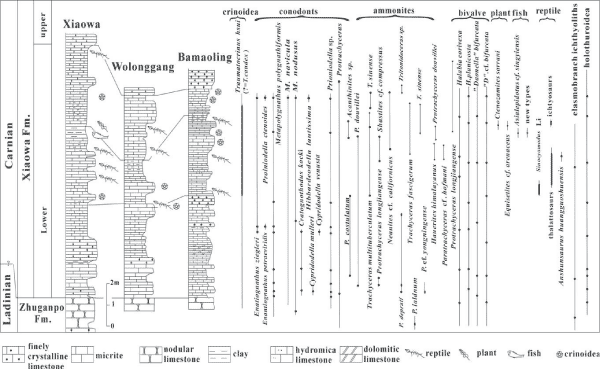
Click on thumbnail to enlarge the image.
Table 2: Stratigraphic range of principal fossil groups in GFG.
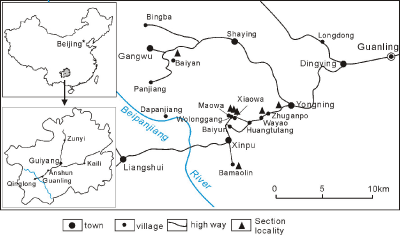
Click on thumbnail to enlarge the image.
Figure 1: Geographic map with indicators of measured sections (black triangles). The location of Wolonggang is marked by the triangle south-west of the village of Xiaowa.
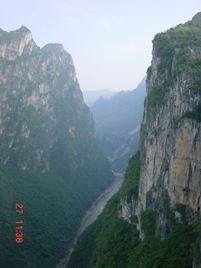 |
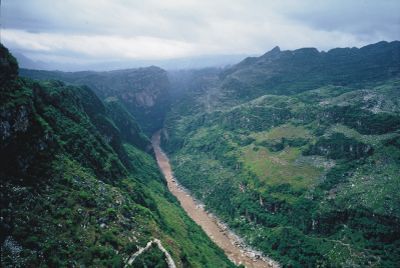 |

|
|
Click on thumbnail to enlarge the image.
Figure 2: The Huangjiang Big Gorge, so called "the crack of the earth". 2a. Huangjiang Big Gorge; 2b. landscape of the Huangjiang Big Gorge; 2c. rocky "sea" comprising karst mountains around the Huajiang Big Gorge.
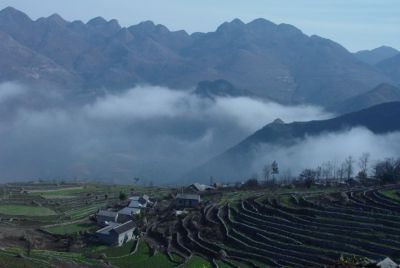 |
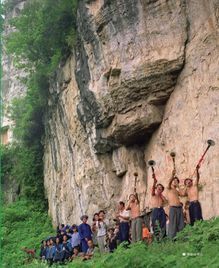 |
Click on thumbnail to enlarge the image.
Figure 3: 3a. Maowa village near Wolonggang with beautiful landscape; 3b. A group of local ethnic people celebrating on an outcrop.
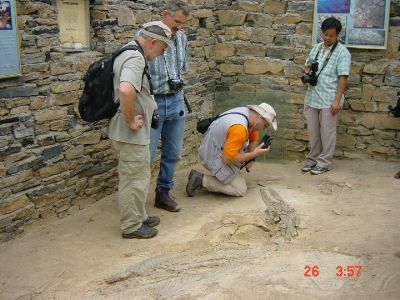 |
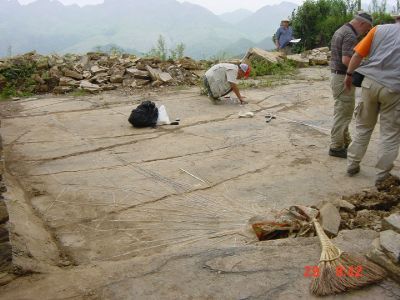 |
Click on thumbnail to enlarge the image.
Figure 4: Marine reptile and crinoid colonies preserved on the black shale and mudstone bedding planes in the Wolonggang. 4a. Ghuizhouichthyosaurus tangae & in et alii, 2000 (= Cymbospondylus asiaticus C. & , 2002, and ? = Panjiangsaurus epicharis X. & , 2003), nearly complete skeletons, Wolonggang; 4b. Traumatocrinus colonies. Large colony WMTH-10 consisting of a 3.3 m long driftwood log with crinoids attached to both ends. Stem lengths range from ca. 1 to > 7.4 m, allowing plankton filtering of the colony at different water depth. Most of the stems straight, bent in walking stick manner below crowns. Crowns of longest individuals not preserved. Lower Xiaowa Formation, Wolonggang.
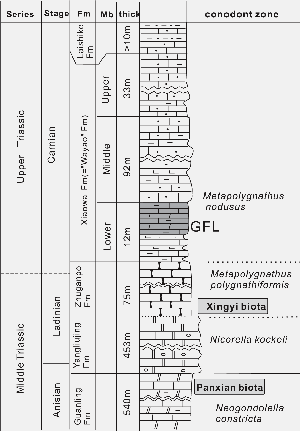
Click on thumbnail to enlarge the image.
Figure 5: Middle–Upper Triassic stratigraphic subdivision of the Guanling area with the indicators of the interval yielding the Guanling Fossil Group (GFG), Xingyi and Paxian biotas.
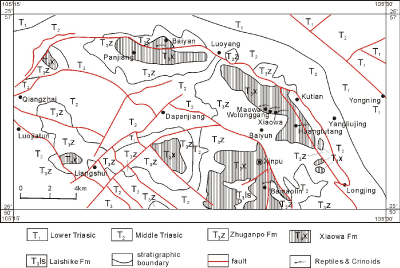
Click on thumbnail to enlarge the image.
Figure 6: Distribution of the Guanling fossil group.
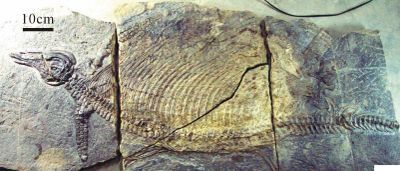
Click on thumbnail to enlarge the image.
Figure 7: Ichthyosaur Qianichthyosaurus zhoui C. , 1999. YIGMR TR00040, nearly complete skeleton, 1.28 m long. Note embryos below rib cage of mother.
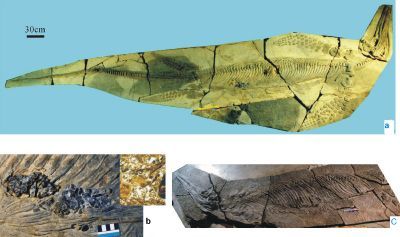
Click on thumbnail to enlarge the image.
Figure 8: Ichthyosaur Guizhouichthyosaurus tangae & in et alii, 2000 (= Cymbospondylus asiaticus C. & , 2002, ? = Panjiangsaurus epicharis X. & , 2003). 8a. Complete skeleton with 5.385 m long, Holotype, TR00001, Scale equals 30cm; 8b. Gastroliths composed mainly of siliceous limestone and quartzite in same skeleton as fig. 1, Scale equals 5cm; 8c. An incomplete skeleton with the gastroliths, composed of fish scales and fragments of bivalve and brachiopod shells, with 210cm long, TR00041. The scale equals 15cm.
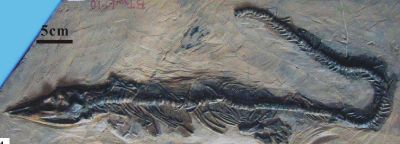
Click on thumbnail to enlarge the image.
Figure 9: Thalattosaur Xinpusaurus suni ( et alii, 2000), complete skeleton with 80cm long, BT3wL-01.

Click on thumbnail to enlarge the image.
Figure 10: Thalattosaur Xinpusaurus bamaolinensis , 2003 (= Xinpusaurus kohi et alii, 2004), holotype YIGMR SPCV30015, complete skeleton 1.4 m long.
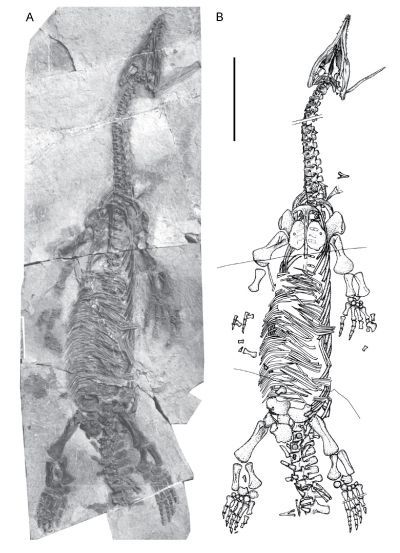
Click on thumbnail to enlarge the image.
Figure 11: Thalattosaur Anshuisaurus huangguoshuensis (J. , 1999). 11a. Photograph of nearly complete skeleton in ventral view; 11b. Drawing of the same skeleton. Scale bar in a-b represents 30 cm.
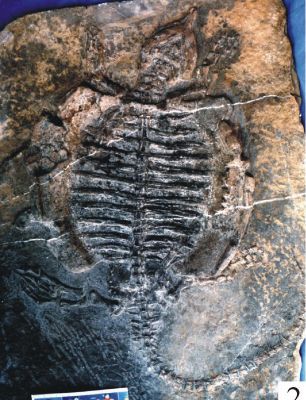 |
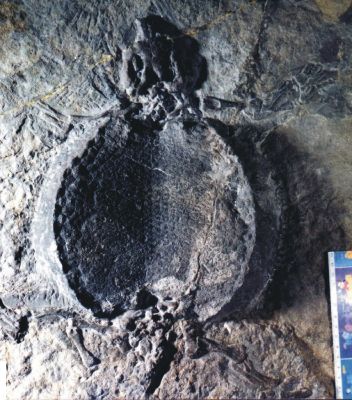 |
Click on thumbnail to enlarge the image.
Figure 12: Placodont Sinocyamodus xinpuensis C., 2000. 12a.YIGMR TR00046, complete skeleton preserved in ventral viewl; 12b. YIGMR TRO0043, complete skeleton preserved in dorsal view. Scale bar in 1-2 represents 5 cm.
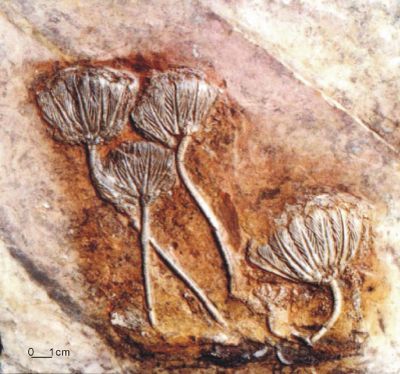
Click on thumbnail to enlarge the image.
Figure 13: Traumatocrinus hsui , 1949 [? = T. caudex (, 1866)]. 1. Colony of 4 juvenile individuals with short columns, attached by root cirri to a piece of agatized drift wood. IV 30024.
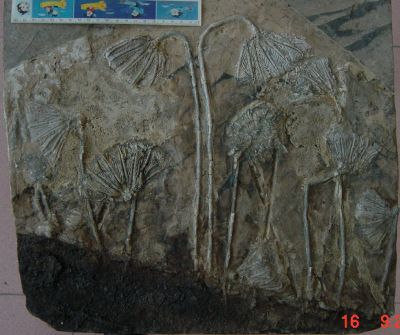
Click on thumbnail to enlarge the image.
Figure 14: A colony of Traumatocrinus sp. with 10 juvenile individuals, attached to a agatized driftwood by root cirri (XT3wC-1), Scale bar represents 5 cm.
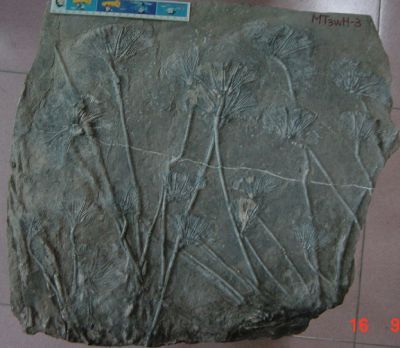
Click on thumbnail to enlarge the image.
Figure 15: A colony of Traumatocrinussp. with more than 17 juvenile and immature individuals, attached to a agatized driftwood by root cirri (MT3wH-3), Scale bar in 1-2 represents 5 cm.
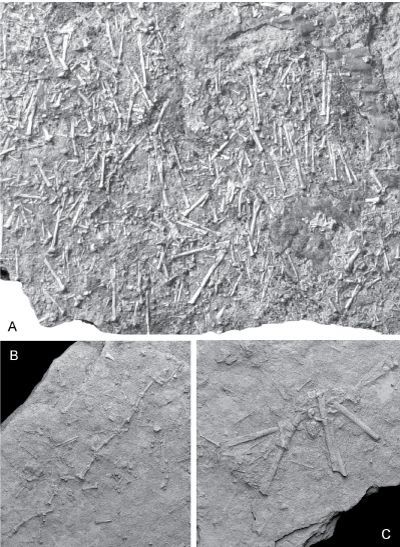
Click on thumbnail to enlarge the image.
Figure 16: Osteocrinus spp. 16a. A bedding plane with disarticulated ossicles. Note preferred orientation. Width of image is 20 mm. YIGMR CROS001; 16b. An arm fragment of Osteocrinus sp. in initial state of disarticulation. Width of image is 6 mm. YIGMR CROS002. C, Osteocrinus cf. O. virgatus, low cone-shaped centrodorsal with radials and long bone-shaped first primibrachials in association. Width of image is 6 mm. YIGMR CROS003.
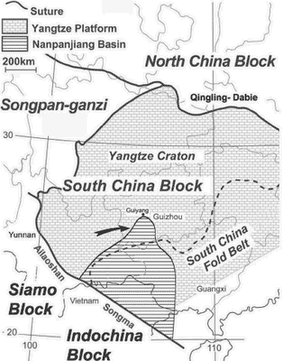 |
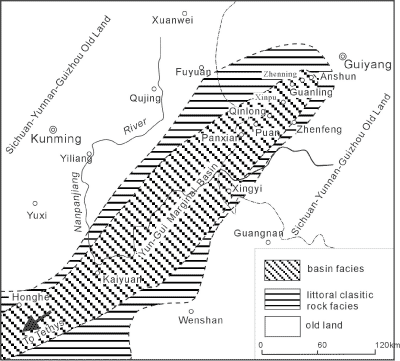 |
Click on thumbnail to enlarge the image.
Figure 17: 17a. Tectonic map of South China with Yangtze Platform and Nanpangjiang Basin in Late Triassic times. Arrow indicates the study area near Guanling. Modified from et alii (1989), et alii (2005) and X. et alii (2008); 17b. Late Triassic paleogeographic reconstruction of the Guanling area (modified from X. et alii, 2003a).
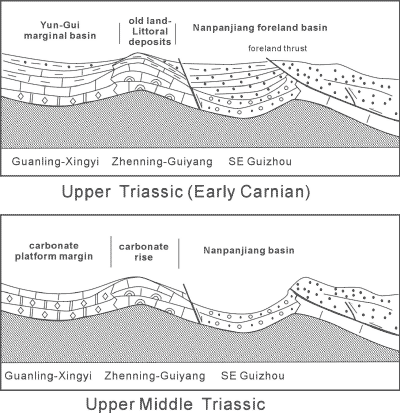
Click on thumbnail to enlarge the image.
Figure 18: The paleogeographic evolution of the Guanling and its adjacent area from the Middle to Upper Triassic.
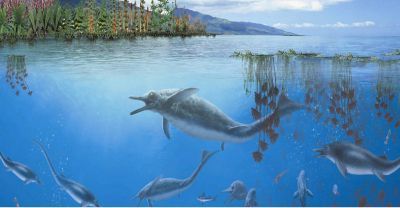
Click on thumbnail to enlarge the image.
Figure 19: Ecological and environmental reconstruction of the GFG.
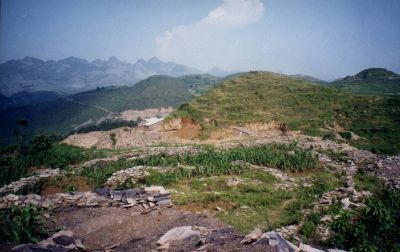
Click on thumbnail to enlarge the image.
Figure 20: The unnatural and terrible appearance of the Wolonggang (originally un-named mountain) near Xiaowa due to destructive excavation.
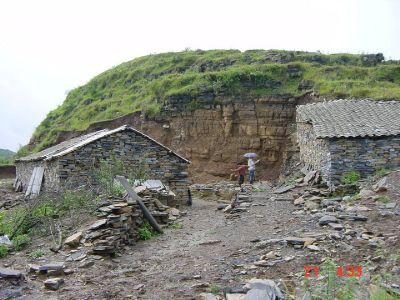
Click on thumbnail to enlarge the image.
Figure 21: Mounting in 2002 slabs or thin bedded limestones of the Lower Xiaowa Formation in Wolonggang at the natural museum.
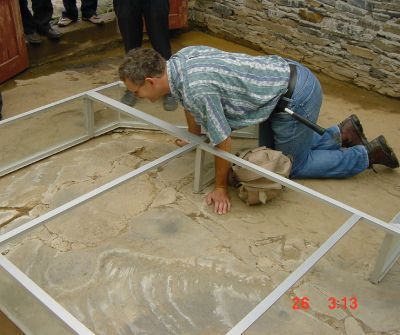
Click on thumbnail to enlarge the image.
Figure 22: Guizhouichthyosaurus tangae & in et alii, 2000. Another complete reptile skeleton preserved on the bedded plane, Lower Xiaowa Formation in Wolonggang natural museum.
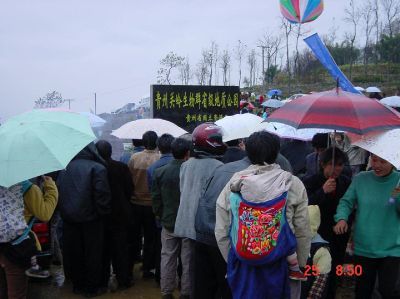 |
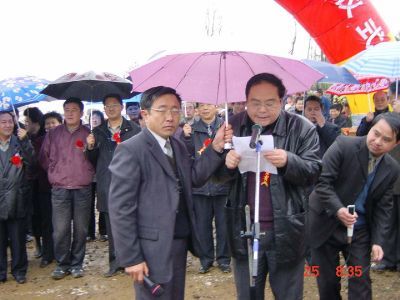 |
Click on thumbnail to enlarge the image.
Figure 23: Opening ceremony for the State GeoPark of Gangling fossil group held in Wolonggang in December, 2003. The Chinese characters on the stone tablet mean State GeoPark of Gangling fossil group. 23a. Local farmers attended the ceremony under heavy rain; 23b. The Mayor of Guanling County Government made a opening address.
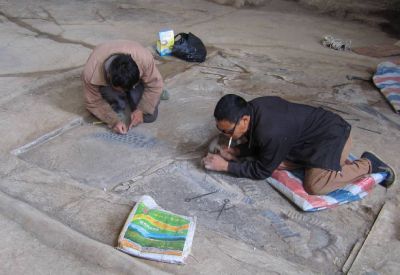
Click on thumbnail to enlarge the image.
Figure 24: Preparing the marine replete skeleton preserved in their original position on the black mudstone bedding planes for national GeoPark in Wolonggang.
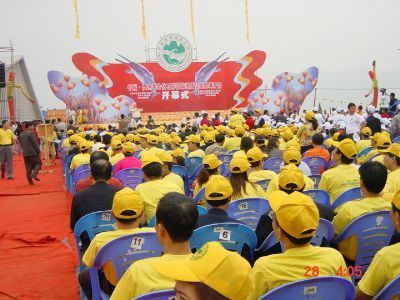
Click on thumbnail to enlarge the image.
Figure 25: Several hundred peoples participated in the opening ceremony of the NGGFG held in the Wolonggang in August 28, 2006.
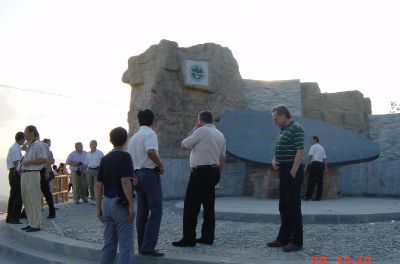
Click on thumbnail to enlarge the image.
Figure 26: The monument erected at the gate of the Guanling GeoPark briefly describes the content of Guanling biota in Chinese and English, and states that it is protected and conserved for the future.
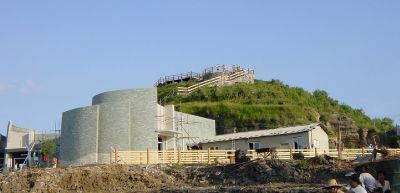
Click on thumbnail to enlarge the image.
Figure 27: Gangling Fossil Group National GeoPark and key conservation zone as determined in the Wolonggang area.
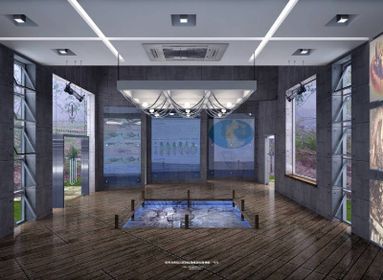 |
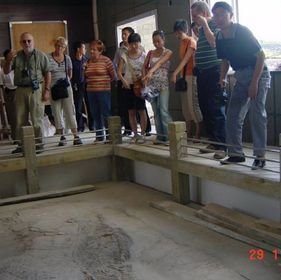 |
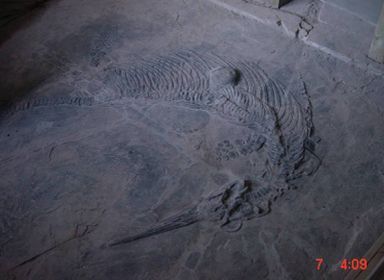 |
Click on thumbnail to enlarge the image.
Figure 28: Marine reptile exhibition room of the national GeoPark. 28a. showing the decoration of exhibition room; 28b. visiting the reptiles; 28c. Ghuizhouichthyosaurus tangae & in et alii, 2000, shown in the natural museum.
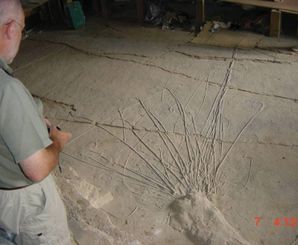 |
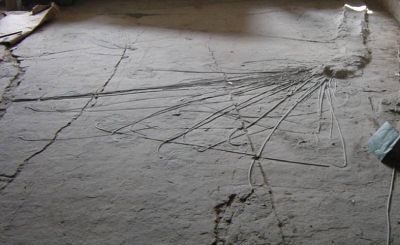 |
Click on thumbnail to enlarge the image.
Figure 29: Crinoid exhibition room. 29a. colony of Traumatocrinus sp. attached by root cirri to an agatized piece of driftwood; 29b. same specimen as above.
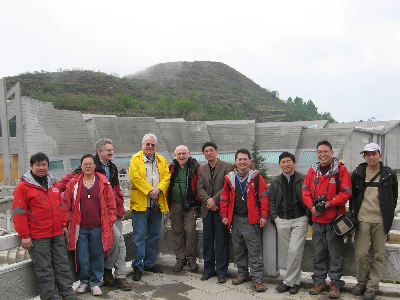
Click on thumbnail to enlarge the image.
Figure 30: Paleontologists of the Guanling Research Group, along with some leaders from the protection and conservation office of the Guanling fossil group, standing in front of the GeoPark museum at Wolonggang.